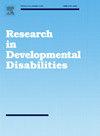长期经皮耳迷走神经刺激对普拉德-威利综合征患者昼夜节律迷走神经活动的影响:病例系列
IF 2.9
2区 医学
Q1 EDUCATION, SPECIAL
引用次数: 0
摘要
背景普拉德-威利综合征(Prader-Willi Syndrome,PWS)是一种遗传性神经发育障碍疾病,主要表现为昼夜节律和自主神经系统(ANS)活动紊乱、食欲亢进和情绪失控。以前的试验表明,有创和无创迷走神经刺激(VNS)可减少 PWS 患者的情绪爆发,这可能是通过其对迷走神经活动的影响实现的。本病例系列研究了经皮耳廓迷走神经刺激(taVNS)对昼夜节律迷走神经活动的心脏标记物(尤其是心率变异性和心率)的影响,以及它们与情绪失控改善之间的潜在联系。结果测量包括每天的情绪爆发记录以及每三个月一次的 24 小时心率变异和心率记录。应用混合余弦模型分析心率变异和心率的昼夜节律变化。结果与基线相比,治疗结束时心率变异和心率的昼夜节律振幅明显增加(所有 p's < .01)。心率变异的节律调整平均值明显增加(p <.01),而心率的节律调整平均值明显下降,这都表明心脏迷走神经活动增加。结果表明,taVNS 可有效针对 PWS 患者的自律神经系统活动,有助于改善行为调节。本文章由计算机程序翻译,如有差异,请以英文原文为准。
Effects of long-term transcutaneous auricular vagus nerve stimulation on circadian vagal activity in people with Prader-Willi Syndrome: A case-series
Background
Prader-Willi Syndrome (PWS) is a genetic neurodevelopmental disorder marked by disruptions in circadian rhythms and autonomic nervous system (ANS) activity, hyperphagia, and episodes of emotional outbursts. Previous trials suggest that both invasive and non-invasive vagus nerve stimulation (VNS) can reduce emotional outbursts in PWS, potentially through its effects on vagal activity.
Aim
This case series investigated the effects of transcutaneous auricular VNS (taVNS) on cardiac markers of circadian vagal activity, specifically heart rate variability (HRV) and heart rate (HR), and their potential links to improvements in emotional outbursts.
Methods
Five individuals with PWS (mean age: 26.9 years; 3 males, 2 females) received four hours of daily taVNS for 12 months, followed by one month of two-hour daily sessions. Outcome measures included daily recording of emotional outbursts and every three months 24-h HRV and HR recordings. Mixed cosinor models were applied to analyze changes in circadian rhythms of HRV and HR. A linear mixed model was used to assess the predictive value of cardiac vagal activity on emotional outbursts.
Results
Circadian amplitudes of HRV and HR were significantly higher at the end of the treatment compared to baseline (all p’s < .01). There was a significant increase in the rhythm-adjusted mean of HRV (p < .01), while the rhythm-adjusted HR mean significantly decreased, both indicating increased cardiac vagal activity. Higher rhythm-adjusted mean HRV predicted a lower number of emotional outbursts.
Conclusion
The results suggest that taVNS may be effective by targeting ANS activity in individuals with PWS, contributing to improvements in behavioral regulation.
求助全文
通过发布文献求助,成功后即可免费获取论文全文。
去求助
来源期刊

Research in Developmental Disabilities
Multiple-
CiteScore
5.50
自引率
6.50%
发文量
178
期刊介绍:
Research In Developmental Disabilities is aimed at publishing original research of an interdisciplinary nature that has a direct bearing on the remediation of problems associated with developmental disabilities. Manuscripts will be solicited throughout the world. Articles will be primarily empirical studies, although an occasional position paper or review will be accepted. The aim of the journal will be to publish articles on all aspects of research with the developmentally disabled, with any methodologically sound approach being acceptable.
 求助内容:
求助内容: 应助结果提醒方式:
应助结果提醒方式:


